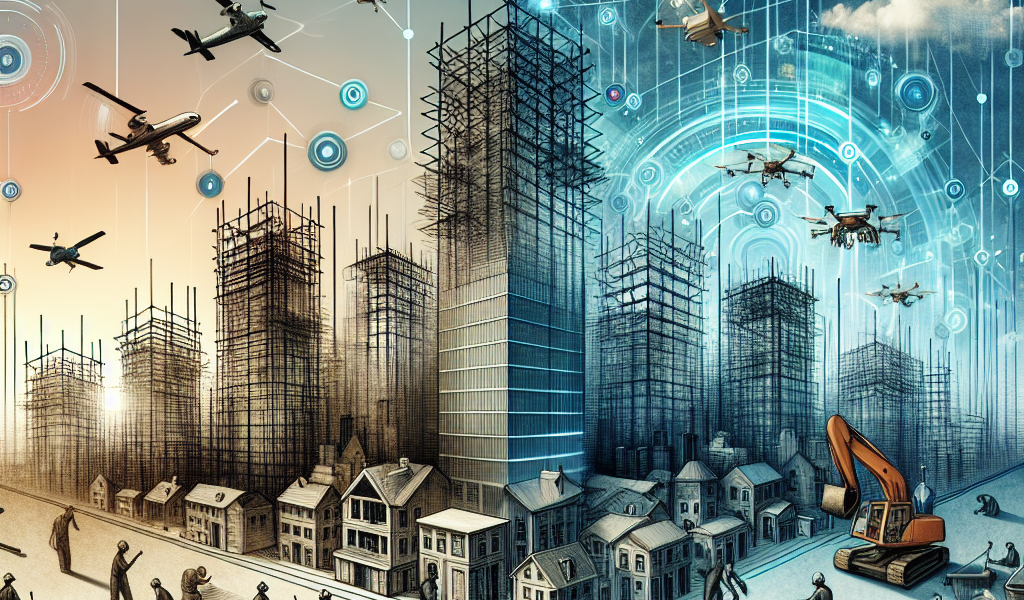-
Table of Contents
“Transforming Spaces: The Future of Real Estate Through Technology”
Introduction

The impact of technology on real estate development has been profound and transformative, reshaping the industry in numerous ways. From the integration of advanced software and data analytics to the adoption of innovative construction techniques and smart building technologies, the real estate sector has experienced significant advancements that enhance efficiency, sustainability, and user experience. Technology has enabled more precise market analysis, streamlined project management, and improved communication among stakeholders. Additionally, the rise of virtual and augmented reality has revolutionized property marketing and visualization, allowing potential buyers and investors to explore properties remotely. As the industry continues to evolve, the ongoing incorporation of cutting-edge technologies promises to drive further innovation and growth in real estate development.
Smart Homes: Revolutionizing Modern Living
The advent of technology has significantly transformed various sectors, and real estate development is no exception. One of the most profound changes has been the rise of smart homes, which are revolutionizing modern living in ways previously unimaginable. As technology continues to evolve, the integration of smart systems into residential properties is not only enhancing convenience but also redefining the very concept of home.
Smart homes are equipped with advanced automation systems that allow homeowners to control various aspects of their living environment through digital devices. These systems can manage lighting, heating, security, and even household appliances, all from a centralized interface, often accessible via smartphones or tablets. This level of control and customization is a significant departure from traditional homes, where manual operation was the norm.
One of the primary benefits of smart homes is the enhancement of energy efficiency. With the ability to monitor and adjust energy consumption in real-time, homeowners can significantly reduce their utility bills. For instance, smart thermostats can learn a household’s routine and adjust heating and cooling systems accordingly, ensuring optimal energy use. Similarly, smart lighting systems can be programmed to turn off when rooms are unoccupied, further conserving energy. This not only benefits the homeowner financially but also contributes to broader environmental sustainability efforts.
In addition to energy efficiency, smart homes offer unparalleled security features. Advanced security systems can include smart locks, surveillance cameras, and motion detectors, all of which can be monitored and controlled remotely. Homeowners can receive real-time alerts on their devices if any unusual activity is detected, providing peace of mind whether they are at home or away. Moreover, the integration of artificial intelligence in these systems allows for predictive analytics, which can identify potential security threats before they materialize.
The convenience offered by smart homes extends beyond energy management and security. Voice-activated assistants, such as Amazon’s Alexa or Google Home, can perform a wide range of tasks, from playing music to setting reminders and even ordering groceries. This level of automation simplifies daily routines and enhances the overall living experience. Furthermore, smart appliances, such as refrigerators that can track food inventory or washing machines that can be operated remotely, add another layer of convenience and efficiency to household management.
However, the rise of smart homes is not without its challenges. One of the primary concerns is data privacy and security. As these systems collect and store vast amounts of personal data, they become potential targets for cyberattacks. Ensuring robust cybersecurity measures is crucial to protect homeowners’ information and maintain the integrity of smart home systems. Additionally, the initial cost of installing smart home technology can be prohibitive for some, although prices are gradually decreasing as the technology becomes more widespread.
Despite these challenges, the trend towards smart homes shows no signs of slowing down. Real estate developers are increasingly incorporating smart technology into new builds, recognizing the growing demand for such features among prospective buyers. This shift is not only meeting current market needs but also setting new standards for future developments.
In conclusion, smart homes are undeniably revolutionizing modern living by offering enhanced convenience, energy efficiency, and security. As technology continues to advance, the integration of smart systems in residential properties is likely to become even more sophisticated, further transforming the real estate landscape. While challenges such as data privacy and initial costs remain, the benefits of smart homes are compelling, making them an integral part of contemporary and future living.
Virtual Reality: Transforming Property Showcases
Virtual reality (VR) is revolutionizing the real estate industry, particularly in the realm of property showcases. This cutting-edge technology offers a transformative approach to how properties are presented and experienced by potential buyers and investors. By creating immersive, three-dimensional environments, VR allows individuals to explore properties from the comfort of their own homes, thereby eliminating geographical barriers and enhancing the overall efficiency of the property viewing process.
One of the most significant advantages of VR in real estate is its ability to provide a realistic and comprehensive view of a property. Traditional methods, such as photographs and videos, often fail to capture the true essence of a space. In contrast, VR enables users to navigate through a property as if they were physically present, offering a more accurate representation of the layout, dimensions, and overall ambiance. This immersive experience can be particularly beneficial for off-plan properties, where buyers can visualize the final product long before construction is completed.
Moreover, VR technology can significantly reduce the time and resources spent on property viewings. Real estate agents and developers can create virtual tours that potential buyers can access at any time, eliminating the need for multiple in-person visits. This not only streamlines the process for buyers but also allows agents to focus their efforts on more serious inquiries, ultimately leading to more efficient transactions. Additionally, VR can be integrated with other digital tools, such as interactive floor plans and augmented reality (AR) features, to provide a more comprehensive and engaging experience.
The use of VR in real estate also has the potential to enhance marketing strategies. By offering virtual tours on their websites and social media platforms, developers and agents can reach a broader audience and generate more interest in their properties. This innovative approach can set them apart from competitors and position them as forward-thinking leaders in the industry. Furthermore, VR can be used to create personalized experiences for potential buyers, allowing them to customize and visualize different design options, such as furniture layouts and color schemes, to better suit their preferences.
Despite its numerous advantages, the adoption of VR in real estate is not without challenges. The initial investment in VR technology can be substantial, particularly for smaller firms with limited budgets. Additionally, creating high-quality virtual tours requires specialized skills and expertise, which may necessitate hiring external professionals or investing in staff training. However, as the technology continues to advance and become more accessible, these barriers are likely to diminish, making VR an increasingly viable option for a wider range of real estate professionals.
In conclusion, virtual reality is poised to transform the way properties are showcased in the real estate industry. By offering immersive, realistic experiences, VR can enhance the accuracy and efficiency of property viewings, streamline marketing efforts, and provide personalized experiences for potential buyers. While there are challenges to overcome, the potential benefits of VR far outweigh the drawbacks, making it a valuable tool for real estate agents and developers looking to stay ahead in a competitive market. As technology continues to evolve, the integration of VR in real estate is likely to become more widespread, ultimately reshaping the industry and setting new standards for property showcases.
Big Data: Enhancing Real Estate Market Analysis
The advent of technology has revolutionized various sectors, and real estate development is no exception. Among the myriad technological advancements, big data stands out as a transformative force, significantly enhancing real estate market analysis. By leveraging vast amounts of data, developers, investors, and analysts can make more informed decisions, ultimately leading to more efficient and profitable outcomes.
Big data refers to the extensive volume of structured and unstructured data that is generated at unprecedented rates. In the context of real estate, this data encompasses a wide range of information, including property prices, demographic trends, economic indicators, and consumer behavior patterns. The ability to analyze and interpret this data has become a game-changer for the industry, providing insights that were previously unattainable.
One of the primary benefits of big data in real estate market analysis is its capacity to enhance predictive analytics. By examining historical data and identifying patterns, analysts can forecast future market trends with greater accuracy. This predictive capability is invaluable for developers and investors, as it allows them to anticipate market shifts and adjust their strategies accordingly. For instance, if data analysis indicates an upcoming surge in demand for residential properties in a particular area, developers can prioritize projects in that location, thereby maximizing their returns.
Moreover, big data facilitates a more granular understanding of market dynamics. Traditional market analysis often relies on broad, generalized data, which can obscure important nuances. In contrast, big data enables a more detailed examination of specific factors that influence property values and market conditions. This includes analyzing neighborhood-level data, such as crime rates, school quality, and local amenities, which can significantly impact property desirability. By gaining a deeper understanding of these micro-level factors, stakeholders can make more targeted and effective decisions.
In addition to enhancing predictive analytics and providing granular insights, big data also improves risk assessment in real estate development. The inherent uncertainty and volatility of the real estate market pose significant risks for developers and investors. However, by leveraging big data, these risks can be mitigated to a considerable extent. For example, data on economic indicators, such as employment rates and consumer spending, can help predict potential downturns in the market. Similarly, data on environmental factors, such as flood zones and seismic activity, can inform decisions about property development and investment, reducing the likelihood of costly setbacks.
Furthermore, big data has democratized access to information, leveling the playing field for smaller developers and investors. In the past, comprehensive market analysis was often the domain of large firms with substantial resources. Today, however, a wealth of data is readily available through various platforms and tools, enabling even small-scale players to conduct sophisticated analyses. This democratization fosters greater competition and innovation within the industry, ultimately benefiting consumers.
Despite its numerous advantages, the integration of big data into real estate market analysis is not without challenges. Data privacy concerns, the need for advanced analytical skills, and the potential for data overload are significant issues that must be addressed. Nevertheless, the benefits of big data far outweigh these challenges, and ongoing advancements in technology are likely to further enhance its utility.
In conclusion, big data has emerged as a pivotal tool in real estate market analysis, offering unprecedented insights and predictive capabilities. By harnessing the power of big data, developers, investors, and analysts can navigate the complexities of the real estate market with greater confidence and precision. As technology continues to evolve, the role of big data in shaping the future of real estate development will undoubtedly become even more pronounced.
Sustainable Building: Technology-Driven Eco-Friendly Solutions
The real estate industry has undergone a significant transformation in recent years, driven largely by advancements in technology. This evolution is particularly evident in the realm of sustainable building, where technology-driven eco-friendly solutions are reshaping the landscape. As the world grapples with the pressing need to address climate change and reduce carbon footprints, the integration of innovative technologies in real estate development has become not only desirable but essential.
One of the most notable technological advancements in sustainable building is the development of smart building systems. These systems utilize sensors, automation, and data analytics to optimize energy consumption, reduce waste, and enhance the overall efficiency of buildings. For instance, smart thermostats and lighting systems can adjust settings based on occupancy and natural light levels, significantly cutting down on energy usage. Moreover, advanced HVAC systems can monitor and adjust air quality and temperature in real-time, ensuring a comfortable and healthy indoor environment while minimizing energy expenditure.
In addition to smart systems, the use of sustainable materials has gained traction, thanks to technological innovations. Traditional building materials such as concrete and steel are being supplemented or replaced by eco-friendly alternatives like cross-laminated timber (CLT) and recycled materials. CLT, for example, is not only renewable but also has a lower carbon footprint compared to conventional materials. Furthermore, advancements in material science have led to the development of high-performance insulation and glazing solutions that enhance energy efficiency and reduce the need for artificial heating and cooling.
Renewable energy technologies are also playing a pivotal role in sustainable real estate development. Solar panels, wind turbines, and geothermal systems are increasingly being integrated into building designs, providing clean and renewable energy sources. The advent of building-integrated photovoltaics (BIPV) has further revolutionized the sector by allowing solar panels to be seamlessly incorporated into building facades and roofs, thereby maximizing energy generation without compromising aesthetics. Additionally, energy storage solutions such as advanced batteries are enabling buildings to store excess energy generated during peak production times for use during periods of low generation, thus ensuring a consistent and reliable energy supply.
Water conservation is another critical aspect of sustainable building that has benefited from technological advancements. Innovative water management systems, including rainwater harvesting, greywater recycling, and smart irrigation systems, are helping to reduce water consumption and promote efficient use of this precious resource. These systems can be integrated with building management systems to monitor and optimize water usage, ensuring that every drop is used judiciously.
Furthermore, the concept of green building certifications, such as LEED (Leadership in Energy and Environmental Design) and BREEAM (Building Research Establishment Environmental Assessment Method), has gained prominence. These certifications provide a framework for assessing the sustainability of buildings and encourage the adoption of eco-friendly practices. Technology plays a crucial role in achieving these certifications by providing the tools and data needed to meet stringent sustainability criteria.
In conclusion, the impact of technology on real estate development, particularly in the context of sustainable building, is profound and far-reaching. From smart building systems and sustainable materials to renewable energy technologies and water conservation solutions, technological advancements are driving the industry towards a more sustainable future. As the demand for eco-friendly buildings continues to grow, the integration of these technologies will be instrumental in creating a built environment that is not only efficient and resilient but also harmonious with the natural world.
Conclusion
The impact of technology on real estate development has been profound, revolutionizing the industry through enhanced data analytics, improved construction techniques, and streamlined property management. Advanced technologies such as Building Information Modeling (BIM), drones, and virtual reality have increased efficiency, reduced costs, and improved project accuracy. Additionally, smart home technologies and IoT have transformed residential and commercial properties, offering greater convenience and energy efficiency. Overall, technology has driven significant advancements in real estate development, leading to more sustainable, efficient, and user-friendly environments.





